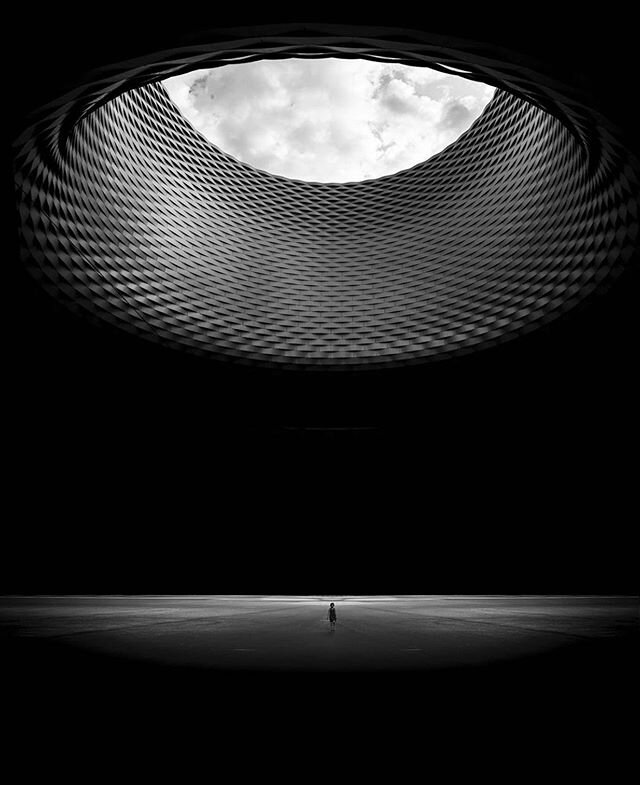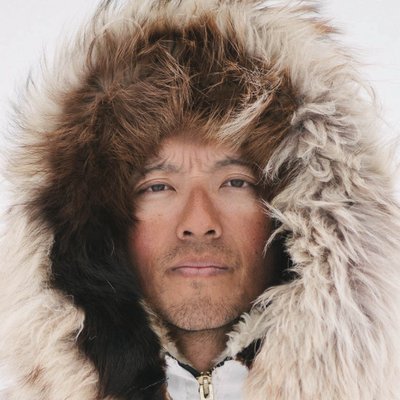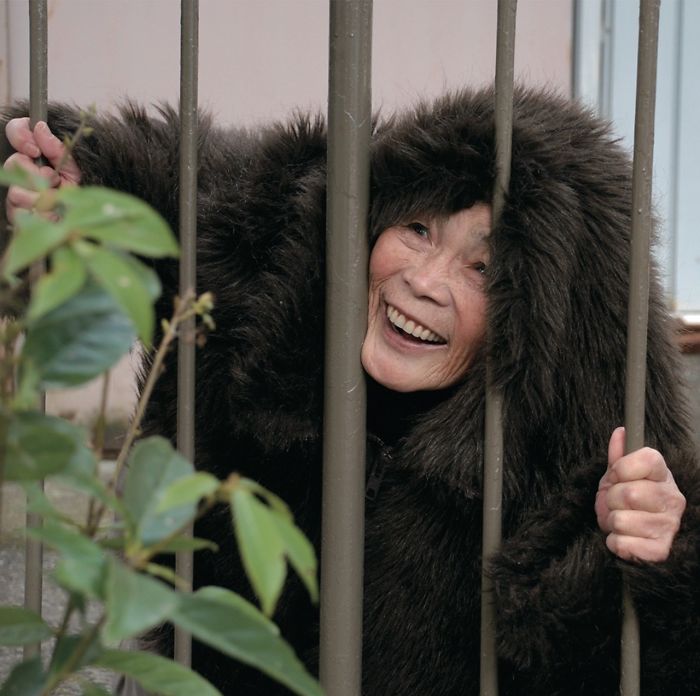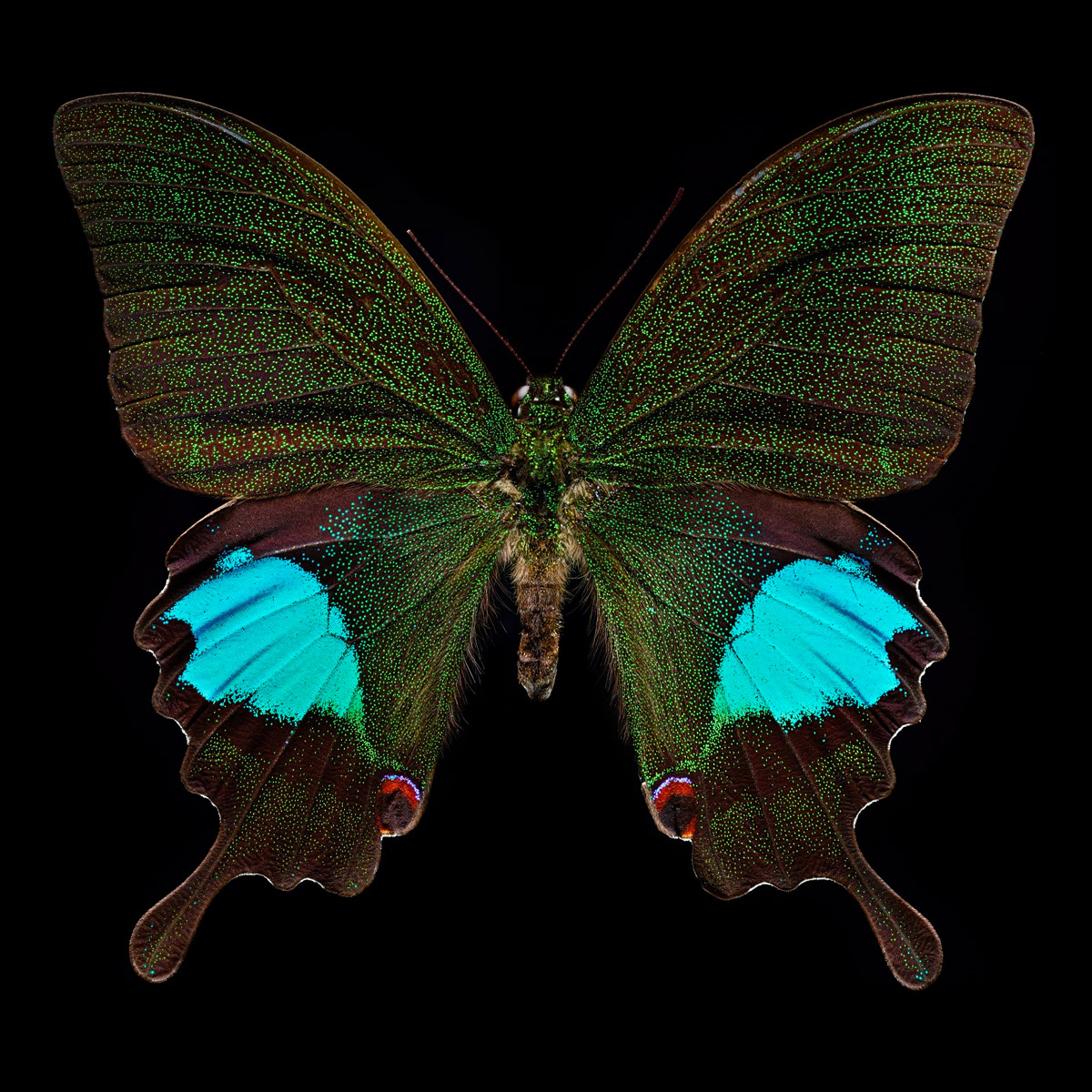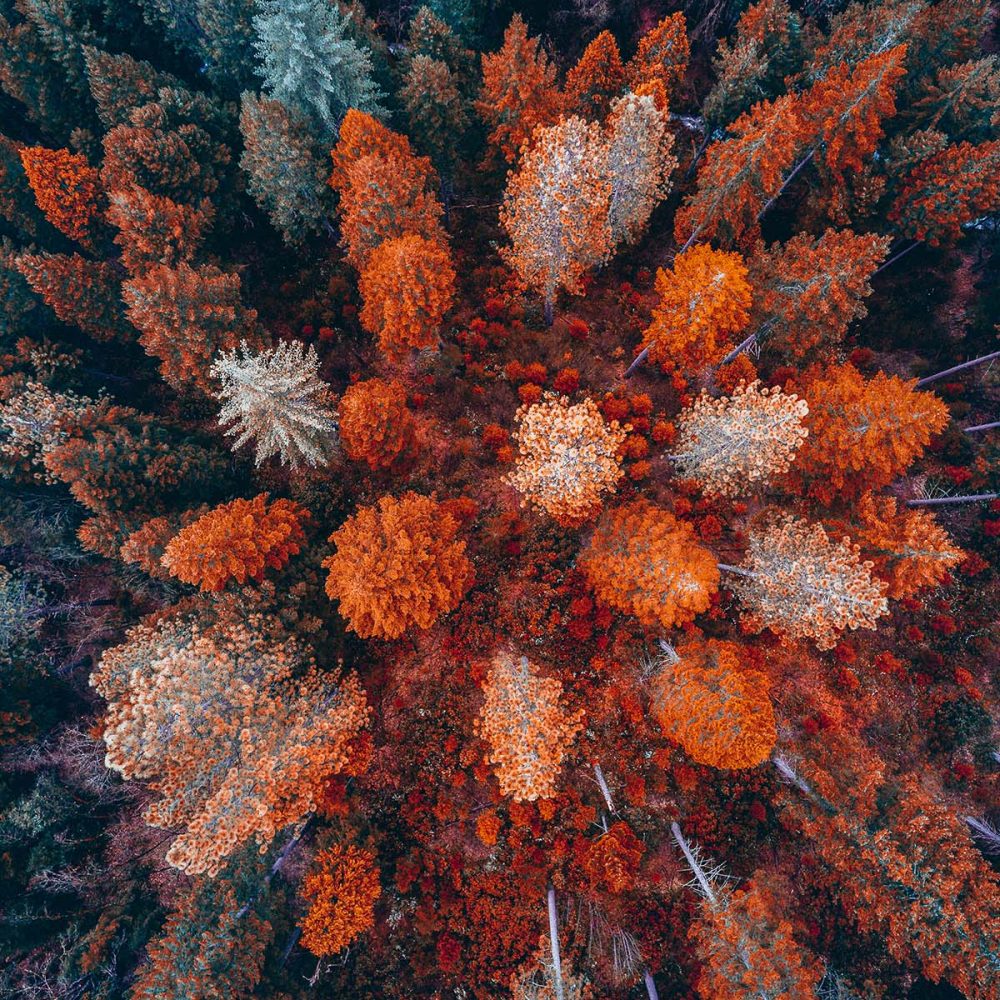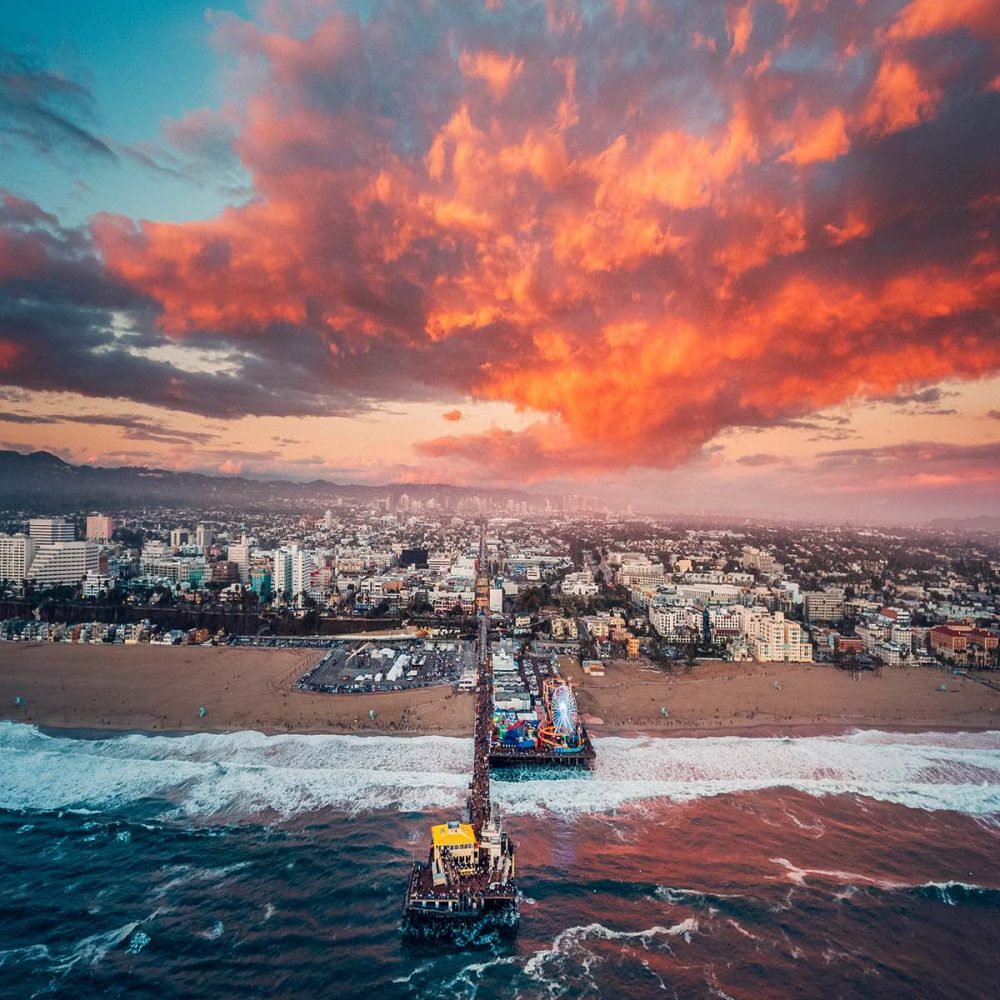Kiliii Yuyan : People of the Whale
Sigvaun Kaleak and his father Raleigh, wearing traditional ice camouflauge parkas, are lifelong whalers. Although European whaling decimated the global whale population by the 1900, the Iñupiat maintained a sustainable harvest of bowheads (via).
The Iñupiat have hunted whales here {high above the Arctic Circle} for millennia, often waiting for fickle sea ice conditions in an era of changing climate. The unpredictability of this coastal Arctic environment means that the Iñupiaq are the carriers of a vast ecological knowledge.
“Kiliii Yuyan is a Nanai (Siberian Native) and Chinese-American photographer whose award-winning work chronicles indigenous and conservation issues.” His “mission is to present collaborative new narratives of indigenous culture. He is fascinated by the essential relationship between humans and the natural world. Kiliii’s photography presents an alternative vision of humanity’s greatest wealth—community, culture and the earth” (via).
And he does a pretty damn good job.
Looks cold, simple, and beautiful.
A rare windless day results in glassy waters at the edge of the sea ice on the Chukchi Sea. Days like this are cherished good weather windows and are the time when the volatile sea ice environment is the safest (via).
You can see all of Kiliii Yuyan’s images from People of the Whale here. His other works are worth checking out too, especially his Living Wild collection which “documents a group of 21st century hunter-gatherers as they rediscover the traditional living skills of the Paleolithic.” It and they are pretty wild.
For more on . . .
Jimmy Chin Photography
photo by Jimmy Chin
After listening to David Goggins curse and cus and create a reality much different from what I’m used to, I’ve been thinking a lot about adventure and pain and pushing myself to the limit. I’ve been inspired.
These images by Jimmy Chin are cut from the same cloth. Because so is Jimmy.
Photo by Jimmy Chin
”Jimmy Chin is a photographer, filmmaker, and mountain sports athlete known for his ability to capture extraordinary imagery while climbing and skiing in extremely high-risk environments” (via).
Photo by Jimmy Chin
“As a filmmaker, his years of experience in the adventure and extreme sports world enables him to bring an authentic and unique perspective to his storytelling. His 2015 film Meru won the coveted Audience Award at the Sundance Film Festival and was on the 2016 Oscar shortlist for Best Documentary” (via).
Photo by Jimmy Chin
Jord Hammond Photography
“Jord Hammond is a 25-year-old freelance contemporary travel photographer and storyteller from the UK. After living and working as a teacher in South-West China for a year, he developed a passion for photography which has led him to all corners of the earth; from the mountains of Peru to the rivers of Varanasi in India and everything in between” (via).
You can catch more of Jord’s work at @jordhammon and on his website, jordhammond.com.
Happy Sunday!
For more on . . .
Nirav Patel Photography
My wife often sends me people, ideas, and links of inspiration. This week she sent me Nirav Patel.
“I am drawn to quiet moments,” writes, “I think it originated from attempts at self-preservation when I was living in neighborhoods that were...difficult” (via).
“I still look for the glimpses of quiet when the world is turbulent. These images are a window into my world” (via).
Reminds me of Tupac’s “The Rose That Grew From Concrete”.
You can follow Nirav on instagram or his website.
For more on . . .
-N- Stuff : Photography : Art : Nirav Patel
Women at a mosque in Tehran, Iran.
I just love this image by Ebrahim Noroozi.
For more on . . .
TIME's 100 most influential images
In this unprecedented exploration of 100 photographs that shaped the human experience, TIME goes behind each spectacular image to reveal how and why it changed the course of history (via).
There is no formula that makes a picture influential. Some images are on our list because they were the first of their kind, others because they shaped the way we think. And some made the cut because they directly changed the way we live. What all 100 share is that they are turning points in our human experience (via).
Here are a few of my favorites so far:
You can explore the stories behind the top 100 photographs, or you can watch short documentaries of the top 20 OF THE MOST INFLUENTIAL PHOTOS OF ALL TIME.
For more on . . .
A flower from my wife
“The heart is a bloom, shoots up from the stony ground.”
A lyric that follows me now, down every dirt road path and onto the old cracked sidewalks, where little girls giggle as they silly talk and my mind drifts again to another world we lived in. A place that taught me a plant can survive in the most surprising, sometimes inhospitable places. And the human spirit can thrive, even in change, even if smothered or weary.
Beautiful flowers can grow out of concrete.
- Josey Miller (@storyanthology)
Yeah, she’s pretty awesome.
Click here for more thoughts, pictures, and inspiration from my wife,
Long shadows cast on the camel caravan.
Photo by @jarradseng
Love this image. And the host site the reposted it, @stayandwander. If ever you want to feel the feels, spend a few minutes meandering around their account. You won't be disappointed.
For more on . . .
2018 National Geographic Travel Photographer of the Year
National Geographic recently announced the winners of the Travel Photographer of the Year contest for 2018. You can see the winners here and the people’s choice awards here.
I don't know why, but that alligator one really intrigues me. Maybe it's because I just spent the last ten days in a cabin on a lake and watched my kids play, almost daily, some form of king of the mountain (on rafts). I bet that's what those gators are doing too. And if I were the current king, I'd be leery of the big momma coming to claim her throne . . . sheesh.
For more on . . .
-N- Stuff : Photography : best of . . .
View of Life in a One-Room Home
"For eighteen years, {Masaki Yamamoto's} family of seven coexisted in a one-room apartment in Kobe. His father drove trucks, and his mother worked as a cashier in a supermarket. They and their five children all slept in the same space, a room the size of six tatami mats, limbs overlapping amid a pile of ever-multiplying junk. When you looked up, you couldn’t avoid meeting the eyes of someone else, Yamamoto, the second-oldest of his siblings, said, adding, 'The one place you could be alone was the bathtub.' 'Guts,' his new photography book, is a celebration of his family’s everyday existence in these close quarters (via).
"The power of Yamamoto’s photos lies in this subversion of the viewer’s expectations. Yamamoto is clear-sighted and un-nostalgic about his family’s precarious economic circumstances. When he was eight years old, the family was evicted from their previous apartment in Kobe. They all lived out of a car for a month, and Yamamoto and his siblings spent time in a children’s home before being reunited with their parents. In one photo, Yamamoto shows his mother playing rock, paper, scissors with her husband, to decide whether their money should go to his pachinko games. The camera focusses on the bills clenched tightly in her fist" (via).
Photographs by Masaki Yamamoto
Kinda puts a lot of my life - my needs, wants, expectations, disappointments and fears - into perspective.
You can read and see more here, at The New Yorker.
For more on . . .
Photography : -N- Stuff : Ebrahim Noroozi: Iranian Coal Miners : Hong Kong in the 1950s : Standing, for a moment, with refugees : jtinseoul : Loud yet Clear
Featured Photographer : Sebastiao Salgado
Sebastião Salgado’s early influences included Lewis Hine, W Eugene Smith and Walker Evans. Much like his heros, Salgado developed a style in black and white that found beauty in brutal subjects of poverty, hardship and oppression of various cultures under the wake of industrialization to the native landscape (via).
With a photojournalistic, monochromatic style that combines complexity with a high sense of drama, his work is dedicated to awareness of conditions of both wildlife and humans (via).
Salgado’s work raised global awareness to varying human conditions which revealed "the often harsh conditions of large scale industrial sites including oil fields and commercial fisheries" (via).
In 2004, after decades of seeing and capturing the worst humanity has to offer, "his work shifted to landscape and wildlife as he began his work on Genesis, a collection of images from some of the most remote parts of the world."
"Salgado aimed to capture landscape that is completely untouched by humans" (via).
For forty years, Salgado documented deprived societies in hidden corners of the world, and the images, the people, and the experiences slowly yet methodically took its toll - his soul became sick, "I no longer believed in anything," Salgado found, "in any salvation for the human species."
It was then that he returned to his Brazilian home to began a new project: restoring the rainforest and mending his soul.
For a deeper, more intimate glimpse into Sebastiao Salgado's heart and mind and camera, check out The Salt of the Earth, a film directed by Salgado's son that explores the life and loves and work of the brilliant Sebastião Salgado.
Here's a trailer of the film.
Little did I know that I was going to discover much more than just a photographer.
And so will you.
For more on . . .
-N- Stuff : Photography : Inspiring art : Salgados's Instagram : Documentaries
Featured Photographer : Hajjat Hamidi
Thanks to my wife, I recently came across this Iranian photographer, Hojjat Hamidi, and I think it's time you do too.
Untitled
Untitled
Ever wonder what people are thinking? I do. And I could sit and stare and wonder at this photograph for hours.
Shepherd and his lamb
The Horse Story
When my wife saw this she said, "Who takes photos like this?" and I wasn't sure how to answer because I couldn't pull myself out of this moment. Just gorgeous.
To see more of Hojjat Hamidi photos, follow him on Instagram. He has over 26.6k followers, so I don't think you'll be disappointed.
For more on . . .
89-Year-Old Japanese Grandma Discovers Photography, Can’t Stop Taking Hilarious Self-Portraits Now
Kimiko Nishimoto, an 89-year-old Japanese grandma has been snapping and editing her own pictures for the last 17 years, and her pictures are fantastic.
"Her son was teaching a beginner's course and so she decided to enroll, unaware that she was about to awake a passion and a talent she never even knew she had" (via).
"She had her first solo exhibition ten years later, at a local museum in her home town of Kumamoto, and now she's about to have her work exhibited at Tokyo's Epson epsite imaging gallery. Titled “Asobokane" - meaning "let's play" - the exhibition will feature previously unseen work from the octogenarian artist" (via).
There are so many things to love about this woman and her work, but one that sticks out to me most is her love and joy of artistic expression.
After 72 years, Kimiko Nishimoto hasn't given up on offering her spirit and joy to the world, she's investing - perhaps more than ever - to the soundtrack of humanity.
For seventeen years she's been enjoying and playing with photography. Seventeen years. For me, that's half a lifetime. For her, it's a whole new beginning.
And after 89 years, the voice of her new beginning, her gift to the world, is a smile.
And that is both inspiring and encouraging.
For more on . . .
-N- Stuff : Creativity : Inspiring Art
BE SURE TO SCROLL DOWN AND SUBSCRIBE - THANKS FOR READING!
My Fares : The people Joseph Rodriguez saw through the windshield.
Joseph Rodriguez drove a cab from 1977 to 1985, and in the last two of those years, he was studying to be a photographer. He lost his first set of gear in a classic ’70s New York stabbing and mugging, but with a new camera, he documented what he saw on the job (via).
“I loved the frenetic energy of the city at that time. I once picked up a guy from the Hellfire club, an S&M club, and by the time I dropped him off on the Upper East Side, he had changed his leather cap and everything and put on a pink oxford shirt and some penny loafers. ‘Good morning, sir,’ the doorman said.”
Meatpacking District | “ ‘Don’t I look sexy?’ she said. ‘Hey, how are you today?’ My response was ‘Oh, you look very pretty.’ And then she did that.”
We are what we've always been. Imperfect, beautiful, and fantastically human.
For more on . . .
-N- Stuff : Photography : Joseph Rodriguez Photography : Early Photos of NYC
BE SURE TO SCROLL DOWN AND SUBSCRIBE - THANKS FOR READING!
Microsculpture : The Insect Portraits of Levon Biss
what I loved most about these pictures and his process was the reminder that everyday things, everyday annoyances can often become something very different, very beautiful even, if only seen in a different way.
And that is encouraging.
Microsculpture is a ground breaking project by the British photographer Levon Biss that presents insect specimens from the Oxford University Museum of Natural History like never before . . . Microsculpture was first exhibited in the main court of the Oxford University Museum of Natural History. Surrounded by the museum’s stunning Neo-Gothic architecture, the largest of Microsculpture’s photographic prints measured up to three metres across and surrounded the visitor. Seen alongside the tiny insect specimens themselves, this huge transformation of scale offered a unique viewing experience" (via).
Although much smaller than three meters, these images are still stunning.
Jewel Longhorn Beetle
At high magnification the surface of even the plainest looking beetle or fly is completely transformed as details of their microsculpture become visible: ridges, pits or engraved meshes all combine at different spatial scales in a breath-taking intricacy. It is thought that these microscopic structures alter the properties of the insect’s surface in different ways, reflecting sunlight, shedding water, or trapping air (via).
Marion Flightless Moth
Levon photographs the insect in "approximately 30 different sections, depending the size of the specimen. Each section is lit differently with strobe lights to bring out the micro sculptural beauty of that particular section of the body. For example, I will light and shoot just one antennae, then after I have completed this area I will move onto the eye and the lighting set up will change entirely to suit the texture and contours of that specific part area of the body. I continue this process until I have covered the whole surface area of the insect" (via).
Paris Peacock
Ruby Tailed Wasp
You can see many more of these ridiculous images here, and if you do, don't pass up on the Treehopper. It might be my favorite.
Treehopper
But the Branch Back Treehopper is pretty amazing too . . . and the Tricolored Jewel Beetle.
Here's the madness behind the process:
You can also check Levon Biss' TED Talk and more of his non-insect work here.
For more on . . .
-N- Stuff : Photography : National Geographic
BE SURE TO SCROLL DOWN AND SUBSCRIBE - THANKS FOR READING!
Some pretty awesome drone shots
Nature and Romance
Niaz is a director, commercial photographer and film maker based out of Los Angeles who loves "creating awesome stuff!"
These arial shots seem to fall easily into such a category.
Laguna Beach
Lost in a Forest
California Sunset
Pursuit of Happiness
Floating
Santa Monica
You can see more of Niaz's work in his portfolio or follow him on Instagram.
For more on . . .
-N- Stuff : Guardian's best drone photography : Photos
BE SURE TO SCROLL DOWN AND SUBSCRIBE - THANKS FOR READING!
Standing, for a moment, with refugees
Refugees, primarily from Syria, Afghanistan and Iraq prepare to board a train at a refugee transit camp, or reception center for refugees and migrants, in Gevgelija, Macedonia on October 2, 2015.
The refugee crisis is inescapable in today’s news. Striking visuals emerging from Europe, the Middle East, and Africa illustrate a story of both desperation and hope. These images allow viewers to stand for a moment alongside migrants and refugees fleeing their home countries in search of a new life and new opportunities.
Refugees and migrants enter a registration and transit center in Opatovac, Croatia, on October 7, 2015. Approximately 4000-5000 people, mostly from Afghanistan, Iraq, and Syria, pass through this border town every day on their way to Western Europe.
On November 14-15, the Tufts Institute for Global Leadership (IGL) and VII Photo Agency mark 10 years of collaboration with a series of seminars and workshops at VII Perspectives: Migration. VII founder and Chair of IGL’s Program for Narrative and Documentary Practice, Gary Knight, will be joined by leading VII photojournalists for two days of dialogue and hands-on experience. A selection of several of the photographers’ work on the refugee crisis is highlighted below (via).
One thousand migrants and refugees from countries including Iraq, Syria, Pakistan, and Afghanistan, as well as regions of the Balkans and Africa at an emergency shelter at Olympia Stadiom in Berlin, Germany on September 24, 2015.
Photos by Ashley Gilbertson
Ashley Gilbertson’s images capture refugees – mostly from Iraq, Syria, Pakistan, and Afghanistan, as well as regions of the Balkans and Africa – on their way into and through Europe during September 2015.
The exodus of people from Africa, Central Asia, and the Middle East to Europe is the largest movement of people since World War II. Working in the refugee transit centers, which see thousands of people daily, the photographer notes that conditions at some of the camps are getting slightly better. However, some conditions – such as five hour train rides packed so tightly there is no room to move beyond the spot people are standing – reflect challenges in addressing the scale of the crisis.
Refugees primarily from Syria, Iraq and Afghanistan are called to by volunteers as they land near Scala, on the island of Lesvos, Greece on September 30, 2015.
Refugees primarily from Syria, Iraq and Afghanistan are helped by volunteers as they disembark boats near Scala, on the island of Lesvos, Greece on September 30, 2015. The Agean sea is particularly rough, with the first signs of winter storms beginning today. Many refugees were sea sick, some to the point of life threatening conditions due to dehydration and cold.
Kadoni Kinan, 26, a volunteer, helps a young Syrian boy as he disembarks a boat near Scala, on the island of Lesvos, Greece on September 30, 2015. Kadoni Kinan left his home in Saragep, Syria five years ago. Kinan successfully filed for refugee status, and today lives in Belgium, where he studies Flemish at school and volunteers for the Red Cross.
Photos by Ed Kashi
In November 2013, photographer Ed Kashi went to Iraq and Jordan, working with the International Medical Corps (IMC). IMC is a humanitarian non-profit organization that provides aid and relief to those affected by conflict and crisis.
The photographer’s work reflects IMC’s efforts to increase awareness and improve not only the physical, but also the mental health of young refugees plagued by depression, fear, suffering, and the sense of a life turned upside down. His images intimately llustrates the plight of this lost generation.
Children gather in an enclave of tents at the Al Za'atri refugee camp for Syrians near Mafraq, Jordan on Nov. 25, 2013.
A young girl enjoys a lollipop while watching shoppers in the Domiz Camp for Syrian Refugees just outside of Dohuk, Iraq on Nov. 23, 2013.
Refugees walk through the overcrowded Al Za'atri refugee camp for Syrians, near Mafraq, Jordan on Nov. 17, 2013. There, International Medical Corps, IMC, is pushing to increase awareness and improve not only the physical, but also the mental health of young refugees plagued by depression, fear, suffering, and the sense of a life turned upside down.
Photos by Ron Haviv
Like Maciek Nabrdalik’s, this selection of Ron Haviv’s photographs are centered on the Lesvos, Greece. There, he has captured the work of volunteers helping refugees to arrive safely, as well as the migrants’ journey once they have made it to shore.
A refugees looks towards Turkey after arriving on the Greek island of Lesbos.
Refugees arrive on the Greek island of Lesbos.
A Spanish volunteer lifeguard helps refugees arrive on the Greek island of Lesbos.
While looking at these images of hope and love, I couldn't help but think, "Where is America?"
Then I remembered. We're building walls.
For more on . . .
-N- Stuff : Amazing Photos : Humanity
BE SURE TO SCROLL DOWN AND SUBSCRIBE - THANKS FOR READING!
Nat Geo's Travel Photos of the Year
"The results of the 2017 National Geographic Travel Photographer of the Year Contest are now in, with grand-prize winner Sergio Tapiro Velasco set to receive a 10-day trip for two to the Galápagos Archipelago with National Geographic Expeditions, for his incredible shot of lightning striking the erupting Colima Volcano in Mexico (below). National Geographic was kind enough to allow {ALAN TAYLOR} to share the winners and honorable mentions with us here, from three categories: Nature, Cities, and People. The photos and captions were written by the photographers, and lightly edited for style" (via)
The Power of Nature - Grand Prize and 1st Prize Nature Category. Powerful eruption of Colima Volcano in Mexico on December 13th, 2015. That night, the weather was dry and cold, friction of ash particles generated a big lightning rod of about 600 meters that connected ash and volcano, illuminating the dark scene. In last part of 2015, this volcano showed a lot of eruptive activity with ash explosions that raised 2-3 km above the crater. Most of the night explosions produced incandescent rock falls and lightning not bigger than 100 meters in average
Al Ain - Honorable mention, Cities. New city on the desert.
The Man’s Stare - Honorable mention, People. The photo was taken on July 23rd 2016 at Tongi Railway Station in Gazipur, Bangladesh. I was there taking photos and waiting for a moment. A train from Dhaka toward another district stopped at the platform for 5 minutes for lifting passengers. It was raining a lot. Suddenly I found a pair of curious eyes looking at me through the window and on his left an umbrella has been put to protect from the rain. I got the moment.
Interesting Moment - 2nd Place, People. Museum visitors curiously watching Rembrandt's painting "Syndics of the Drapers' Guild" where it gave the illusion that the people on the paintings too are curiously watching the visitors.
My favorite is "The Man's Stare." What a captured moment.
For more on . . .
-N- Stuff : Amazing Photos : Nat Geo 2016 Year in Photos : Portrait Photography of Martin Schoeller
BE SURE TO SCROLL DOWN AND SUBSCRIBE - THANKS FOR READING!
Michel D'Oultremont : More than a Photograph
The following video, and Michel D'Oultremont's works, are breathtaking. But, hidden in his words and disguised by the beauty of the film, is something bigger, something beyond photography, that I can't quite pin down. It's there, gnawing, scratching, and unrelenting, like a thorn, buried in the flesh, that won't go away.
I've watched it several times, till, finally, I watched it with my eyes closed, substituting people in for animals. Then, some truths for life come into focus (see what I did there? Clever!).
Truths like:
"I tried to put more distance between me and the {people}, to have more breathing space in the image, to have something more constructed . . . I tried to put more importance on the environment or the play of light, rather than the {person themselves}."
"Patience is one of the most important things to have. Without patience it's not possible to see {people}" because, "When challenges accumulate, they shouldn't hold you back, they should be an extra motivation. Because the next day, everything might change." But only if we're patient, and if we're there.
"I think this kind of project is really important for our future, for all of us really."
Perhaps the most important of it's kind.
For more on . . .
-N- Stuff : Faces of Humanity : Photography : Humanity
BE SURE TO SCROLL DOWN AND SUBSCRIBE - THANKS FOR READING!

